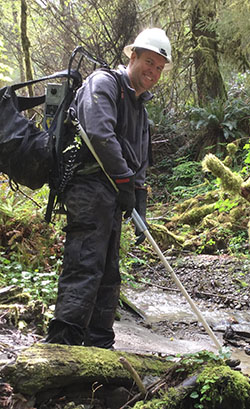
Simpson surveying Guthrie Creek in Humboldt County to determine the extent of existing and restorable fish habitat. Photo by CDFW’s Dan Hansen.
Nicholas “Nick” Simpson is a senior environmental scientist (specialist) with CDFW’s Northern Region, based in Eureka. He works in the Timberland Conservation Program helping to manage natural communities on privately owned timberlands. He is responsible for ensuring that timber operations will not lead to significant or long-term negative impacts on aquatic communities. Simpson’s work includes technical support for CDFW timber staff reviewing timber harvesting plans, lake and streambed alteration agreements, threatened/endangered species consultations, incidental take permits, and habitat conservation plans. Nick is also conducting studies to evaluate the effects of timber operations such as water diversions, road construction and riparian zone management on aquatic communities.
Nick earned his Bachelor and Master of Science Degrees in freshwater fisheries and natural resources at Humboldt State University. Prior to coming to CDFW in 2013, he worked in the private and public sectors as a hydrologist and fisheries biologist, where he evaluated past and current timber harvesting effects on aquatic communities on the North Coast.
Who or what inspired you to become a scientist?
My father and grandfather introduced me to fishing and diving at a young age, and I became fascinated with all things swimming. Exploration led to questions, which ultimately formed a drive to conduct scientific evaluations. Later, as a Fisheries major at Humboldt State University, I became intrigued by the extensive network of local salmon-bearing rivers and streams on private timberlands. Under the context of historical and current logging practices, as well as recent salmonid population declines, I wanted to study the effectiveness of conservation strategies being applied in these watersheds.
What is a typical day like for you at work?
A typical day may include a variety of field inspections including proposed timber harvesting plan reviews, sensitive species or lake and streambed alteration agreement consultations, or compliance/effectiveness inspections of completed projects. My day consists of meeting with foresters and other agency representatives at the closest location we can drive to with a truck, then utilizing all-terrain vehicles and hiking to access remote forest locations. Inspections help ensure that fish and amphibian habitat were delineated accurately, and appropriate riparian buffers are clearly flagged in the field. In addition, watercourse crossings are commonly evaluated to assess their appropriateness and functionality and whether reconstruction, removal or maintenance is required. The following day is usually spent writing reports to record my field observations and to support my recommendations.
What is most challenging about your work?
The most challenging aspect of the job is balancing permit review, scientific study/research and landowner outreach. Permit review, in the form of timber harvesting plans and lake and streambed alteration agreements can be intense, especially when timber is selling at a higher price and more permits are in need of review than normal. I find it important to keep a landscape-level perspective, through research and landowner outreach to ensure conservation efforts are maximized in watersheds with critical habitat for sensitive species.
What is the most rewarding project that you have worked on for CDFW?
I recently completed a pilot study evaluating the effects of water diversion on macroinvertebrates in headwater streams. It was a great experience to generate a scientific study to support protective measures used in Lake and Streambed Alteration Agreements. The project also ended up winning the “Early Career Scientist Best Poster” award at the 2017 CDFW science symposium.
I have also been involved with reviewing multiple logging road crossings and fish barrier projects, which, after execution, have ultimately allowed fish access to formerly blocked habitat. It is always rewarding to facilitate the expansion of salmon range and the restoration of habitat.
What is your favorite species to interact with or study?
My favorite species is Coho salmon. Coho’s life history includes a juvenile winter rearing period, which makes this species highly susceptible to logging impacts such as increases in turbidity and sedimentation. Any recent Coho reoccupation of formerly unoccupied habitats (usually after barrier removal, or stream quality restoration) is the ultimate indicator of the effectiveness of forest conservation and restoration efforts. However, we are still learning about the dynamic aspects of streams and salmon, such as juvenile winter rearing and stream limiting factors.
What is it about the work you do that you would most like us to know?
Our website is regularly updated, and is a great resource for those who want to know more about the Timberland Conservation Program. It is located at www.wildlife.ca.gov/conservation/timber.
If you had free reign and unlimited funding, what scientific project would you most like to do?
Large woody debris (LWD) is an important stream component for Coho salmon (Oncorhynchus kisutch). In a recent analysis, we found that 73 percent of Humboldt County Coho streams are depleted in LWD due to historical “stream cleaning” (log harvesting from streams) and past logging practices. It would be great to develop a model to assess the best restoration strategies based on stream channel type and condition.
Do you have any advice for people considering careers in science or natural resources?
I would consider gaining experience in the field you are interested in as early and often as possible. A common misconception in college is that you go to school for four years, graduate, and then obtain your dream job right away. In reality, employers are looking for someone with experience, in addition to the basic academic knowledge. It is worth putting in the time as a seasonal technician or volunteer while in school to gain that valuable experience.
CDFW Photos. Top Photo: Simpson performing a survey of a tributary to Big River in Mendocino County. It was determined that the waterfall was not a barrier to adult steelhead. Photo by CDFW's Jon Hendrix.